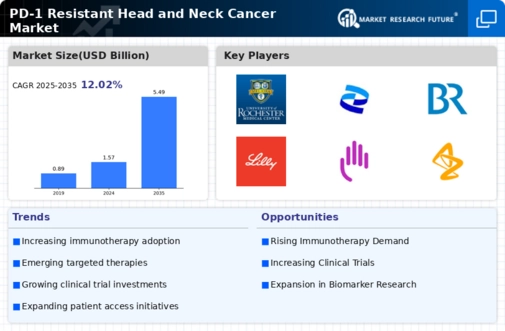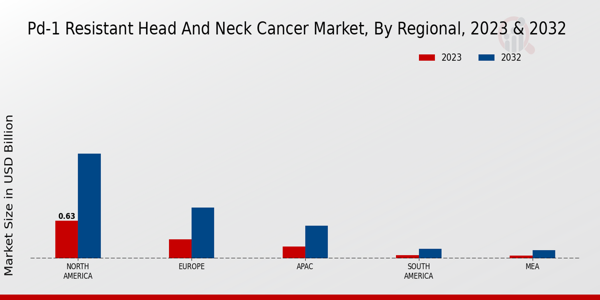Market Growth Projections
The Global PD-1 Resistant Head and Neck Cancer Market Industry is projected to experience substantial growth over the next decade. With an estimated market value of 1.57 billion USD in 2024, it is expected to reach 5.49 billion USD by 2035. This growth trajectory reflects a compound annual growth rate of 12.05% from 2025 to 2035, indicating a robust demand for innovative treatment options. The increasing prevalence of head and neck cancers, coupled with advancements in immunotherapy and research funding, suggests a dynamic market landscape that is likely to evolve significantly in the coming years.
Increased Research Funding
The Global PD-1 Resistant Head and Neck Cancer Market Industry benefits from increased research funding aimed at understanding and overcoming PD-1 resistance. Government and private sector investments are being directed towards innovative research initiatives that explore the underlying mechanisms of resistance and potential therapeutic targets. This influx of funding is likely to accelerate the development of novel treatment options, thereby expanding the market. As research progresses, the industry may witness a surge in new therapies entering the pipeline, which could significantly impact patient outcomes and market dynamics.
Advancements in Immunotherapy
The Global PD-1 Resistant Head and Neck Cancer Market Industry is significantly influenced by advancements in immunotherapy. Recent innovations in treatment modalities, particularly those targeting PD-1 resistance, have shown promise in clinical trials. For instance, combination therapies that incorporate checkpoint inhibitors with other agents are being explored, potentially enhancing treatment efficacy. As these therapies gain regulatory approval, they are expected to capture a larger market share, contributing to the projected growth from 1.57 billion USD in 2024 to 5.49 billion USD by 2035. This trend highlights the ongoing evolution of cancer treatment paradigms.
Emerging Markets and Global Expansion
The Global PD-1 Resistant Head and Neck Cancer Market Industry is poised for growth in emerging markets. Countries with improving healthcare infrastructure and increasing access to cancer therapies are becoming focal points for pharmaceutical companies. As these markets expand, they present significant opportunities for the introduction of novel treatments for PD-1 resistant head and neck cancers. The anticipated compound annual growth rate of 12.05% from 2025 to 2035 underscores the potential for market expansion in these regions, as they adopt advanced therapeutic options and improve patient access to care.
Growing Awareness and Screening Programs
The Global PD-1 Resistant Head and Neck Cancer Market Industry is also driven by growing awareness and enhanced screening programs. Public health campaigns aimed at educating individuals about the risk factors and symptoms of head and neck cancers are leading to earlier detection and treatment. This proactive approach is crucial, as early-stage cancers are often more responsive to therapies, including those targeting PD-1 resistance. As awareness increases, more patients are likely to seek treatment, thereby expanding the market and fostering a more informed patient population.
Rising Incidence of Head and Neck Cancer
The Global PD-1 Resistant Head and Neck Cancer Market Industry is experiencing growth due to the increasing incidence of head and neck cancers worldwide. According to health statistics, these cancers account for a significant percentage of all cancer cases, with an estimated 1.57 million new cases projected in 2024. This rising prevalence necessitates the development of innovative therapies, particularly for patients who exhibit resistance to PD-1 inhibitors. As a result, pharmaceutical companies are investing heavily in research and development to address this unmet medical need, thereby driving market expansion.
























Leave a Comment